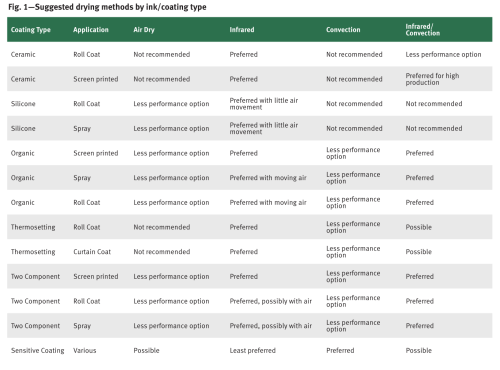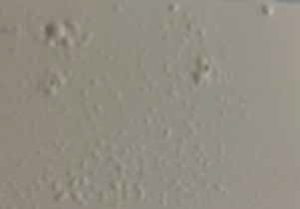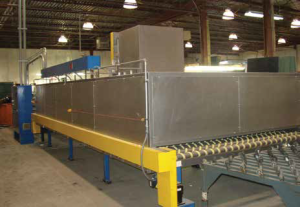Drying and Curing Inks and Coatings on Glass
Editor’s note: This article is the first of a two-part series on inks and coatings. Read how to troubleshoot common problems with inks in the May 2013 issue.
As the application possibilities for decorative glass continue to grow, so does the number of inks and coatings available. These inks and coatings include highly durable ceramic inks that are fired into the glass during a tempering, heat-strengthening or bending process; highly colorful, silicone-based coatings used for obscuration and fallout protection; organic inks for interior wall panels; thermosetting coatings for mirrors; and other specialty protective coatings.
Properly drying and curing these products is critical to creating high quality decorative glass. Following are some tips for fabricators regarding the right techniques and equipment to use when drying and curing inks and coatings on glass.
The Drying Process
Drying of coatings, paints and inks can be accomplished with convection heating, infrared energy, a combination of convection and infrared, UV energy, and air drying. With convection, the air is heated, transferring energy to the surface of the coating. Infrared, like the heat from the sun, provides highly efficient electromagnetic energy directly from the heat source to the coating without heating the air between. Medium wavelength infrared energy is readily absorbed by glass, whereas short wavelength infrared will generally pass through the glass.
Ceramic inks are the most durable, but their colors are limited. Ceramic inks consist of three parts: the colored frit that melts into the glass, a resin that holds the frit in place prior to the firing process, and a liquid medium that allows the ink to be applied. Over the years, the mediums have evolved from fast-drying pine oil to more environmentally friendly watermiscible materials. As the mediums changed, the temperature required to dry the inks increased from about 225 degrees Fahrenheit to 325°F-350°F to achieve the green strength necessary to allow for further processing such as multiple printing and handling. Ceramic inks are also available with a UV medium that “dries” the coating in a matter of seconds, using ultraviolet energy. UV coatings tend to be more costly and are not as commonly used. The preferred method for drying ceramic inks is via infrared drying equipment. (See Fig. 1).

Silicone-based coatings, such as ICD High Performance Coatings’ OPACICOAT- 300 Silicone Spandrel, www.icdcoatings.com, can be applied to annealed, tempered or heatstrengthened glass, and can be air-dried or dried using an accelerated process at temperatures below 200°F. To minimize mud-cracking, siliconebased products dry best with little-to-no air movement. This makes them ideal for infrared drying.
Organic inks and two-component inks dry well with convection or a convection/infrared combination. These inks generally have cure temperatures in the 250°F-350°F range. Exceeding the upper temperature recommended by the manufacturer can result in discoloration that is readily apparent on whites and yellows. It is important that the drying process produces repeatable results, so that the colors applied can be matched in the future.
 |
| An example of blistering and discoloration caused by drying at a too rapid rate |
Drying at too rapid a rate can also cause the surface of the ink or coating to skin over, possibly forming blisters by entrapping solvent below. In addition, too rapid drying can boil the solvent from the coating, creating pin holes. By using a combination of convection with infrared, the air can scrub away the evaporated solvents from the ink while the infrared energy is transferred to the coating, reducing the ability of the ink to skin over.
To accelerate drying of organic and two-component inks, a ramp/ soak approach is commonly used. For example, if the critical temperature is 300°F, infrared alone or in combination with convection can quickly and safely bring the ink to 250°F. Then, lower energy infrared, combination infrared/convection or convection alone can slowly bring the ink to the critical temperature, minimizing the potential for damage. The ramp/soak approach will often reduce the overall drying time as well, shortening the length of the oven and reducing operating costs.
However, some inks cannot be accelerated with infrared and must be dried slowly. Check with your ink or coating manufacturer to see if they can reformulate for use with infrared or a combination of infrared/convection.
Thermosetting coatings—often used for protecting the backs of mirrors — require crosslinking of the components in the coating, which is best accomplished using infrared radiation. “Infrared radiation is a must for thermosetting crosslinking mirror backing paints,” explains Dino Fenzi, president of Fenzi S.P.A., a manufacturer of mirror backing paint, decorative inks/coatings and specialty sealants. “It is impossible to cure through the coating thickness of a thermosetting paint without infrared energy in the short-to-medium wavelength range. Improper curing will result in poor adhesion,” he says.
The Application Process
How the ink or coating is applied to the glass has a large effect on the optimum drying method.
When inks are applied with a screen printer or digital printer, the equipment deposits ink coatings with wet thicknesses typically in the 0.5-2.0 mils range.
Decorative ceramic inks that are either overprinted to achieve greater thickness or changes in color require drying and cooling between prints.
 |
| Electric infrared dryer for ceramic and silicone coatings. Photo by Casso-Solar Technologies LLC. |
For obscuration panels such as spandrel, the coating thickness for a ceramic ink may be 4-5 mils and a silicone ink, 7-14 mils, depending on whether fallout protection is desired. These coatings are commonly applied with a roll coater or spray. For organic and other coatings used for interior decorative panels, coatings will vary from 1-5 mils, and are applied using a roll coater, spray or curtain coater. Coatings used on the back of mirrors to protect the reflective properties are often applied using a roll coater or curtain coater, as well.
Fabricators should evaluate drying systems based upon the paint, ink or coating that is to be processed. A dryer designed for one type of ink might not work for another.
“Different types of enamels or paints require different process parameters,” says Jeff Nixon, general manager of Glass Coatings and Concepts, a manufacturer of ceramic inks and coatings. “For example, water-miscible ceramic enamels don’t require convection to cure perfectly well. In fact, when they are applied heavily, they produce better results in pure IR drying ovens. Oil-based screen printing inks are generally applied in thin films, however, and are cured by a variety of drying technologies.”
When discussing drying systems with your paint, ink or coating manufacturer, ask them if their drying recommendations are based on a convection system, infrared system, a combination infrared/convection system, or ultraviolet method. Typically, an infrared system or combination infrared/convection system will be more efficient than convection alone, providing faster dry times and shorter systems with lower operating costs.

